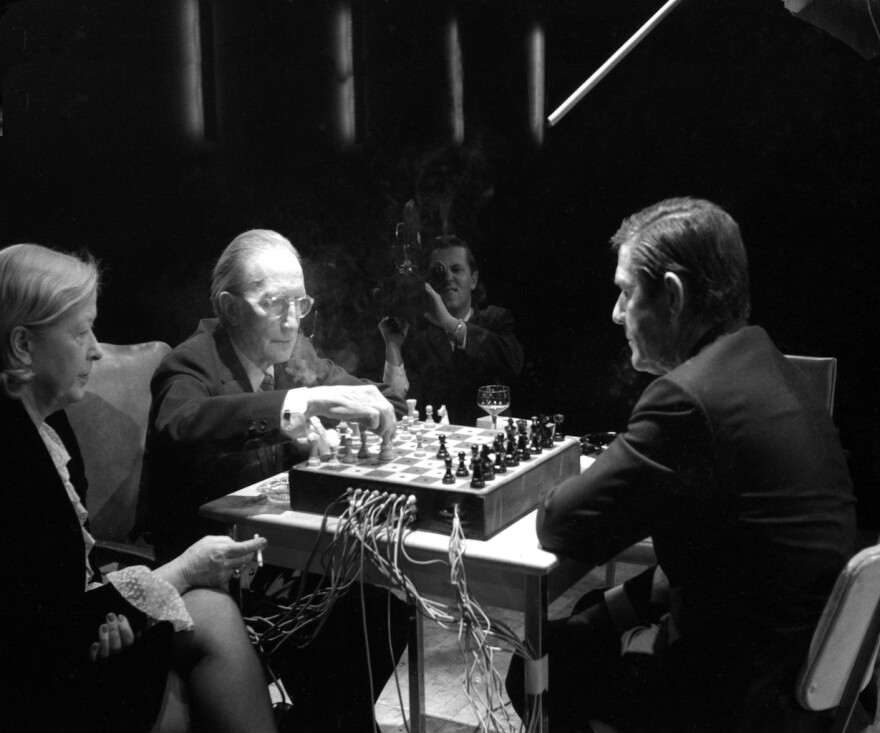The link between the creation of history and the preservation of heritage is about as streamlined as it gets these days: Just send it across the street.
Separated by Maryland Avenue in the Central West End, St. Louis’ chess campus opens up as host to the 2014 U.S. Chess Championships today through May 20, with first moves at 1 p.m. daily. And just as quickly as the Chess Club and Scholastic Center of Saint Louis can write a page into history today, it is recorded as yesterday right across the road at the World Chess Hall of Fame.
There a person will find all the Hall of Fame has accumulated since its creation in 1984 as well as works that speak to the cultural and artistic significance of chess’ 1,500 years-worth of yesterdays. The Hall of Fame has bloomed from a mere house of records since moving to its current home in 2010. This three-floored, 16,000-square-foot showcase in the U.S. capital of chess has come to represent the classy, fashionable side of the street: In stride with the games, yet separated from the horseplay.
Last night, the World Chess Hall of Fame hosted the U.S. Championships’ opening ceremony along with several inductions into history. The World Chess Federation selected Paul Keres and Maya Chiburdanidze into the world hall, while the U.S. Chess Trust selected Abraham Kupchik and Jacqueline Piatigorsky for the U.S Chess Hall of Fame. The Hall of Fame has featured an exhibit on Piatigorsky entitled Patron, Player, Pioneer since last fall, which will now appropriately run through mid-July.

Tonight, however, the hall triumphantly re-opens its doors with two new exhibits, stimulating senses that no over-the-board tactic can match. Michael Graves: Strategy by Design and Cage & Kaino: Pieces and Performances combine for one of the better injections of chess-themed culture inside the galleries, with several visual performances planned as exhibit showcases.
American architect Graves is best-known for his work with Target and J.C. Penney, creating product lines that led modern thinking behind the “democratization of design” for the masses -- high-end design without the high-end cost. Strategy by Design features several games through the eye of Graves, his take on classical games such as backgammon and cribbage, as well as more-recent cult hits Scrabble, Stratego and Monopoly. The primary feature of the exhibit, however, is a chess set that Graves describes as one of his favorite and most-challenging projects.
John Cage and Glenn Kaino were two artists separated by 60 years, but their commonalities through chess inspiration have been brought together by guest curator Larry List, set to culminate in one special night of performance art. The exhibit features Kaino’s life-sized chess set and bronze-cast pieces made of (and by) the artist’s hands, a display named Learn to Win or You’ll Take Losing for Granted. The centerpiece is surrounded by his One Hour Paintings, a portrait series featuring famous grandmasters lost in thought, including Bobby Fischer, Boris Spassky and Jose Raul Capablanca. Two portraits in the collection have not been shown before.

Pieces and Performances will also feature a creation by Cage, a combination electronic-chess and musical-composing board, with each individual square wired to play a unique selection of music. Play a game on it and the hall fills with sound, building in crescendo as more pieces join the middlegame dance. And as they become removed by capture, so does the song; checkmate is left as one final note.
The musical performance is titled Reunion, first observed in 1968 and only once thereafter. Next Thursday, May 15 will mark the third time an audience has ever experienced the concert, featured as part of a planned night of performance art to showcase the exhibit. Visitors will have a chance to create their own unique song of battle using a working replica of the board (which has been appropriately modernized to use musical instruments not yet available to Cage in the ‘60s -- iPods), and the evening will also include a visually mesmerizing piece by Kaino named Burning Boards -- taking the chess “match” rather literally.

Burning Boards is made up of 16 tables, featuring chess boards and armies of candle pieces. Set them aflame and the game is on, using silver tongs in a chess game that gives new meaning to the term “time trouble” -- if a piece melts or becomes stuck to the board, there it stays forever, a useless puddle.
Says List: “Something magical happens as players participate. This game that is about competition and dominance becomes a partnership as they see that they’re struggling against a similar challenge, which is finishing before the pieces melt and become unusable.”
Games or art? A deep discussion, easily explored. Just cross the street.
Brian Jerauld is a chess instructor to area students, including his own children, and a student of the game himself through the Chess Club and Scholastic Center of Saint Louis. He is also a Mizzou journalist with a decade of experience writing about boats, sports and other odds and ends. This column is a weekly look around St. Louis, the U.S. Capital of Chess.




